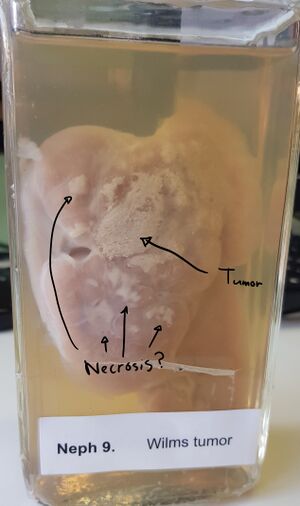25. Wilms tumor: Difference between revisions
(Created page with "'''Organ''': Kidney '''Description''': A greyish, lobulated tumor with no well-defined border can be seen. '''Diagnosis''': Wilms tumor = nephroblastoma '''Causes''': * Sporadic (majority) * Genetic syndromes like WAGR syndrome, Denys-Drash syndrome '''Theory''': Wilms tumor is the most common malignant kidney tumor in childhood, although it can occur in adulthood as well. The tumor is ''triphasic'', meaning it has three different “parts” histologically: # E...") |
No edit summary |
||
| Line 1: | Line 1: | ||
'''Organ''': Kidney | [[File:Wilms tumour prep.jpg|thumb|Wilms tumour prep]]'''Organ''': Kidney | ||
'''Description''': | '''Description''': A greyish, lobulated tumor with no well-defined border can be seen. | ||
A greyish, lobulated tumor with no well-defined border can be seen. | |||
'''Diagnosis''': Wilms tumor = nephroblastoma | '''Diagnosis''': Wilms tumor = nephroblastoma | ||
| Line 14: | Line 12: | ||
'''Theory''': | '''Theory''': | ||
Wilms tumor is the most common malignant kidney tumor in childhood, although it can occur in adulthood as well. | Wilms tumor is the most common malignant kidney tumor in childhood, although it can occur in adulthood as well. The tumor is ''triphasic'', meaning it has three different “parts” histologically: | ||
The tumor is ''triphasic'', meaning it has three different “parts” histologically: | |||
# Epithelial part | # Epithelial part | ||
| Line 22: | Line 18: | ||
# Blastema part | # Blastema part | ||
The blastema part is the most important clinically. A higher proportion of the blastema part compared to the other parts equals a poorer diagnosis. | The blastema part is the most important clinically. A higher proportion of the blastema part compared to the other parts equals a poorer diagnosis. The greyish foci can be necrosis but it’s impossible to know for sure without histology. | ||
The greyish foci can be necrosis but it’s impossible to know for sure without histology. | |||
[[Category:Pathology 2 - Macropreparations]] | [[Category:Pathology 2 - Macropreparations]] | ||
Latest revision as of 12:47, 7 July 2024

Organ: Kidney
Description: A greyish, lobulated tumor with no well-defined border can be seen.
Diagnosis: Wilms tumor = nephroblastoma
Causes:
- Sporadic (majority)
- Genetic syndromes like WAGR syndrome, Denys-Drash syndrome
Theory:
Wilms tumor is the most common malignant kidney tumor in childhood, although it can occur in adulthood as well. The tumor is triphasic, meaning it has three different “parts” histologically:
- Epithelial part
- Stromal part
- Blastema part
The blastema part is the most important clinically. A higher proportion of the blastema part compared to the other parts equals a poorer diagnosis. The greyish foci can be necrosis but it’s impossible to know for sure without histology.
